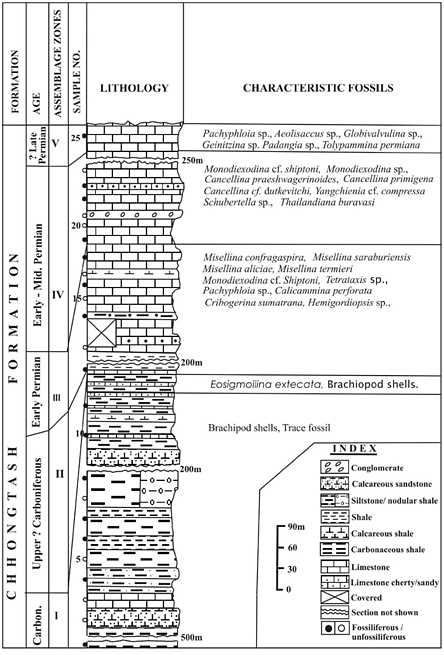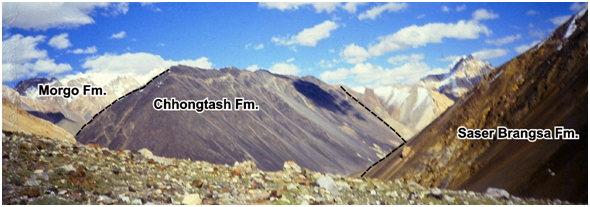Chhongtash Fm
Type Locality and Naming
Upper Shyok Valley: Type section is in Chhongtash locality in Upper Shyok Valley, Eastern Karakoram, India [Original Publication: Gergan, J. T. & Pant, P. C., 1983. Geology and stratigraphy of eastern Karakoram, Ladakh. In: Thakur, V. C. and Sharma, K. K., (eds), Geology of Indus Suture Zone of Ladakh, Wadia Institute of Himalaya Geology, Dehra Dun, India, 99-106; Juyal, K.P. 2018. Lithostratigraphy, biostratigraphy and palaeogeography of the Eastern Karakoram, India. WIHG Monograph series, No. 3. 1-126.]
Lithology and Thickness
Claystone and basalt. Comprises of fragile, splintery carbonaceous shale/slate of huge thickness. Also it contains chert nodules of approximately 5 cm size in the basal part of the sequence. Pillow lava occurs in the lower and middle parts of the Chhongtash Formation. The other lithounits are consolidated as limestone, quartzite, carbonaceous and siliceous shale which are found in the upper part this formation. The thickness of the Chhongtash Formation exceeds 2000 m.
[Figure 1: Biostratigraphic section of Chhongtash Formation (eastern Karakoram) showing the distribution of fauna (Juyal, 2018)]
[Figure 2: Field photograph showing different formational units i.e. Saser Brangsa, Chhongtash and Morgo formations, exposed in the Upper Shyok Valley, eastern Karakoram]
Relationships and Distribution
Lower contact
Not defined, but next older unit is the Aq Tash Fm.
Upper contact
Not defined, but next younger unit is the Morgo Fm.
Regional extent
Upper Shyok Valley: The Chhongtash Formation is spread over 10 km area from Saser Brangsa near Shyok river through Chhongtash to south of Morgo localties.
GeoJSON
Fossils
Foraminifera and other fossils, i.e. bryozoa, algae, corals and also mollusk. The following faunal assemblages zones (Zone-I to V) are recognized in ascending order in this lithounit (Juyal, 2018).
(i) basal Brachiopods shells-Trace fossils Assemblage Zone (Zone-I): This assemblage zone in the lowermost part of the Chhongtash Formation has yielded abundant trace fossils and poorly preserved brachiopods.
(ii) Eosigmoilina explicate-Brachiopod Assemblage Zone (Zone II): This assemblage zone contains Eosigmoilina explicate and abundant brachiopods shells fragments, echinoid and algae.
(iii) Miscellina confragaspira – M. saraburiensis Assemblage Zone (Zone-III): This zone is characterized by the fusulinids taxa which includes Miscellina confragaspira, M. saraburiensis (both zonal fossils), M. aliciae, M. termieri, Miscellina sp., Pseudodoliolina cf. gracilis, Monodiexodina cf. shitoni, Monodiexodina sp., Arminina sp., Tetrataxis (Ebrenberg), and indeterminate taxa of family Schubertellidae, Schwagerinidae and Neofusulinidae etc. Besides, fusulinids this zone has also yielded Pachyphloia sp., Lunucammina sp., Pseuodovidalina sp., Aeolisaccus sp., Globivavulina sp., Climacammina sp., Cribogerina sumatrana, Hemigordiopsis sp., Koskinobigererina breviseptala, Climacammina perforate, Tuberitina sp., Archaediscus sp., Sichotenella sp., and other indeterminate foraminifers, Pseudovermiporella sp., and other indeterminate algal taxa, corals, echinoid, problimatica, turritellids and other shell fragments and bryozoans genus Cryptostome (Primorella) and Rhabdomesen etc. The fusulinids and other foraminiferal taxa, recorded from the Assemblage Zone-III indicate Carboniferous -Lower Permian (Asselian – Artinskian) age to this faunal zone.
(iv) Monodiexodina cf. M. shiptoni–Cancellina cf. C. primigena Assemblage Zone (Zone-IV): This assemblage zone is characterized by the foraminiferal taxa Monodiexodina cf. shiptoni, Monodiexodina sp., Praeneoshwagerinoides cf. primigena, Cancellina cf. dutkevitchi, Cancellina sp., Schubaretella sp., ?Yangchienia sp., and indeterminate taxa of family Boultonidae (fusulina), Pachyphloia sp., Eonodosaria, Globivavulina sp., Thailandina buravasi, Aeolisaccus sp. and Stylolina (other foram), Cryptostome genus (subgenus) Strebtotrypa (streblascopara), Rhabdomesen-Cryptostome other bryozoan, echinoderm and algae. Lower Permian (Artinskian) to Middle Permian (Guadalupian) is present in Assemblage Zone- IV.
(v) uppermost: Pachyphloia - Aeolisaccus Assemblage Zone (Zone-V): This uppermost faunal assemblage yielded fusulinid taxa, namely Schubertella sp., and Cancellina sp., along with other foraminiferal taxa Pachypholia sp., Aeolisaccus sp., Globivavulina sp., Geinitzina sp., Tolypammina sp., Eonodosaria sp., Padangia sp., Thailandiona sp., ? Tetratexis sp., ? Howchinella sp., Nodosinella sp., Cribrogigerina sp., and algal taxa Pseudovermiporella, Gymocodium, bryozoans and echinoderms. Faunal analysis from Assemblage Zone-V shows that these rocks were deposited in late Permian time.
Age
Depositional setting
Not available.
Additional Information

